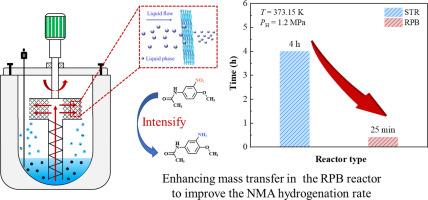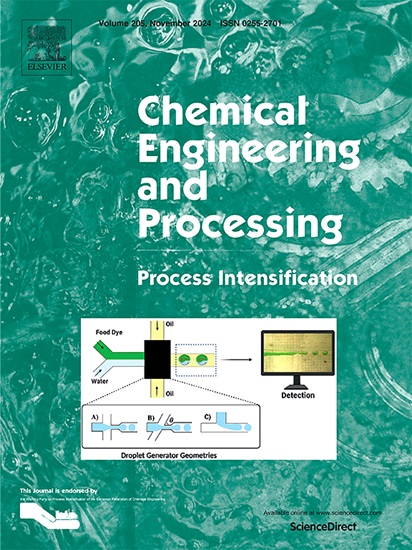Hydrogenation process intensification of 2-nitro-4-acetylamino anisole by HiGee technology
IF 3.9
3区 工程技术
Q3 ENERGY & FUELS
Chemical Engineering and Processing - Process Intensification
Pub Date : 2024-10-09
DOI:10.1016/j.cep.2024.110020
引用次数: 0
Abstract
The catalytic hydrogenation of 2-nitro-4-acetylamino anisole (NMA) is the main path to synthesize 2-amino-4-acetylamino anisole (AMA), belonging to a typical gas-liquid-solid system. However, the small mass transfer rate of traditional hydrogenation reactor can't match its intrinsic fast reaction rate, resulting in the low hydrogenation efficiency. In this work, a rotating packed bed (RPB) reactor with excellent mass transfer performance was applied for the hydrogenation process intensification of NMA. The characterization analysis of the commercial Raney-Ni catalyst shows that the liquid-solid mass transfer resistance during the reaction process can be ignored, and improving the gas-liquid mass transfer rate is the key to improve the macroscopic reaction rate. The effects of operating conditions (solvent, rotational speed, hydrogen pressure, temperature, and catalyst dosage) on NMA conversion and AMA selectivity were investigated. A macro-kinetic equation of NMA catalytic hydrogenation in the RPB reactor was proposed. Under optimized conditions, the NMA was completely converted in the RPB reactor within 30 min, while it took 4 h in the stirred tank reactor. The overall reaction efficiency of RPB reactor was increased by 87.5 % in comparison with STR. This study provides practical guidance for the industrial application of RPB reactor for gas-liquid-solid hydrogenation.

利用 HiGee 技术强化 2-硝基-4-乙酰氨基苯甲醚的氢化过程
2-硝基-4-乙酰氨基苯甲醚(NMA)的催化加氢反应是合成2-氨基-4-乙酰氨基苯甲醚(AMA)的主要途径,属于典型的气-液-固体系。然而,传统加氢反应器的传质速率较小,无法与其固有的快速反应速率相匹配,导致加氢效率较低。本研究将传质性能优异的旋转填料床(RPB)反应器应用于 NMA 的氢化过程强化。对商用 Raney-Ni 催化剂的表征分析表明,反应过程中的液固传质阻力可以忽略不计,提高气液传质速率是提高宏观反应速率的关键。研究了操作条件(溶剂、转速、氢气压力、温度和催化剂用量)对 NMA 转化率和 AMA 选择性的影响。提出了 RPB 反应器中 NMA 催化加氢的宏观动力学方程。在优化条件下,NMA 在 RPB 反应器中可在 30 分钟内完全转化,而在搅拌罐反应器中则需要 4 小时。与 STR 反应器相比,RPB 反应器的整体反应效率提高了 87.5%。这项研究为工业应用 RPB 反应器进行气-液-固加氢反应提供了实际指导。
本文章由计算机程序翻译,如有差异,请以英文原文为准。
求助全文
约1分钟内获得全文
求助全文
来源期刊
CiteScore
7.80
自引率
9.30%
发文量
408
审稿时长
49 days
期刊介绍:
Chemical Engineering and Processing: Process Intensification is intended for practicing researchers in industry and academia, working in the field of Process Engineering and related to the subject of Process Intensification.Articles published in the Journal demonstrate how novel discoveries, developments and theories in the field of Process Engineering and in particular Process Intensification may be used for analysis and design of innovative equipment and processing methods with substantially improved sustainability, efficiency and environmental performance.

 求助内容:
求助内容: 应助结果提醒方式:
应助结果提醒方式:


